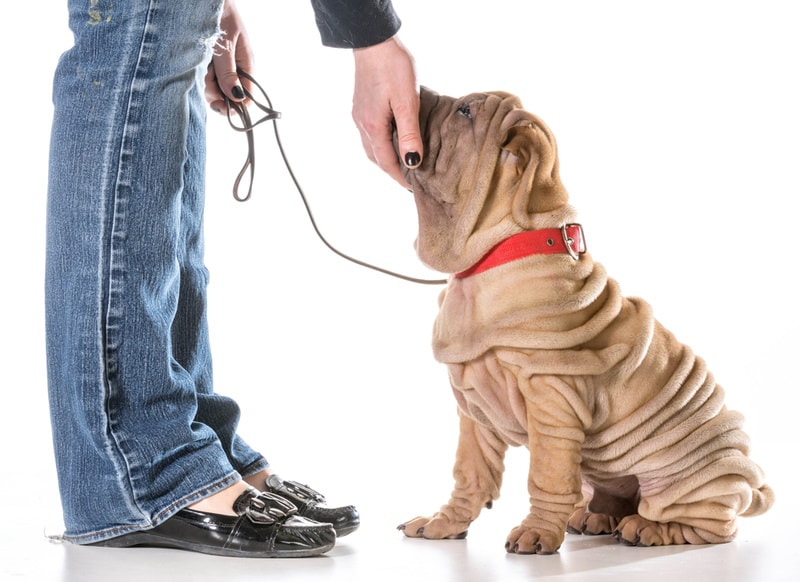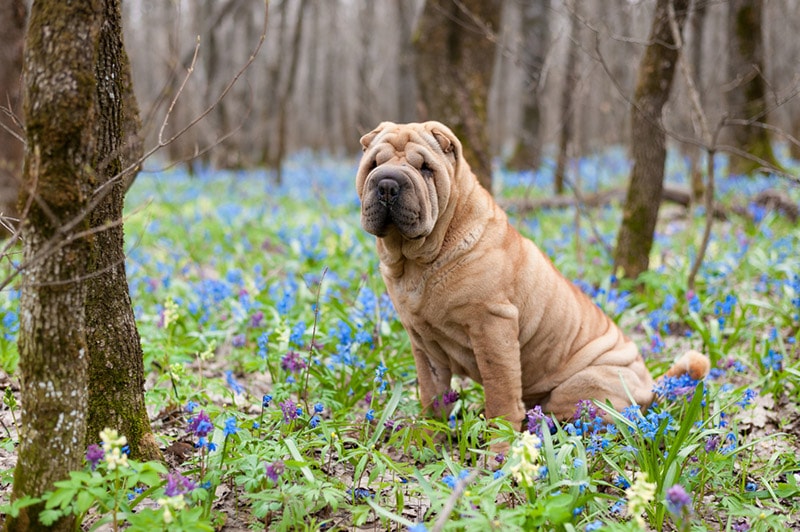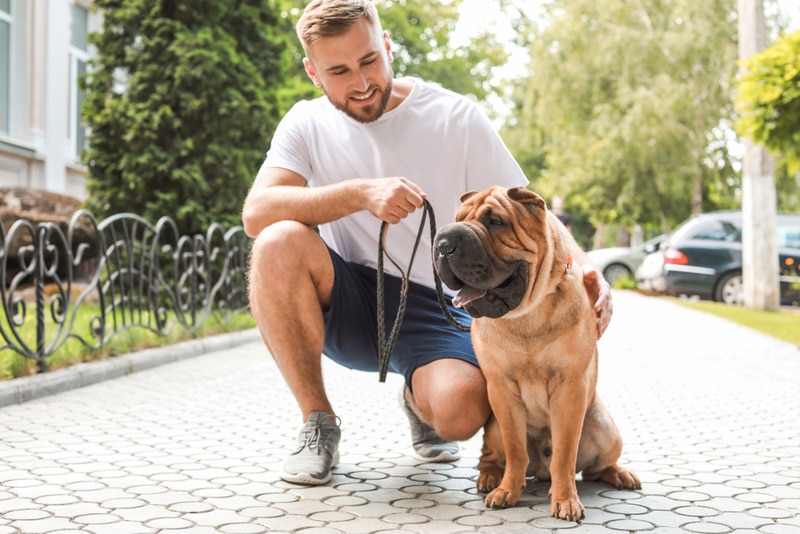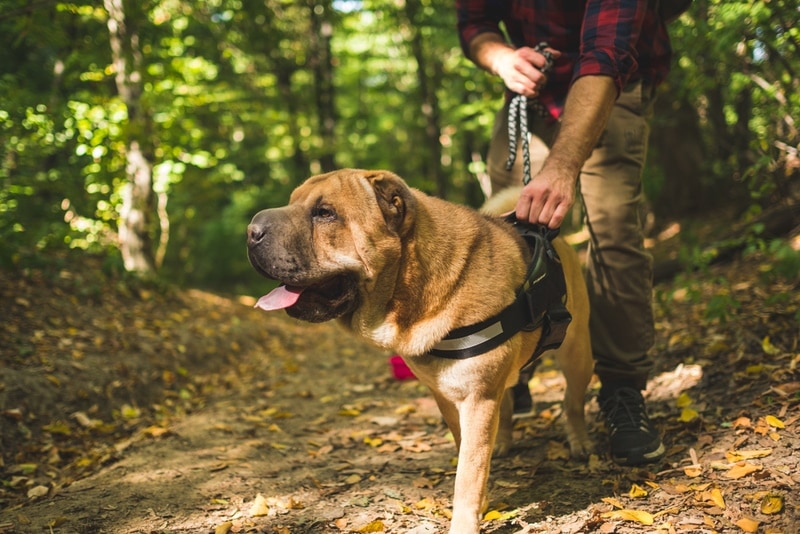
The Shar Pei is a strong, confident, and loyal dog. Hailing from China, they have an imposing demeanor, a witty brain, and an affectionate heart. But they can also be incredibly stubborn. For centuries, this dog has been serving as a guardian, always relying on themselves. That’s exactly why obedience training is essential for this breed!
If you skip early socialization, the Shar Pei will grow into a dominant, bossy beast with little respect for the rules. On the bright side, if you raise them right, your dog will be a docile, even-tempered, and faithful protector. So, how do you potty-train a Shar Pei? How do you make them stop biting and barking? Read on to find out!

The 12 Tips to Training a Shar Pei
We begin our deep dive into Shar Pei training techniques with the basics. Being positive, steering the pup in the right direction with a calm yet firm voice, and keeping the sessions short are how you earn a Shar Pei’s trust. This is an obstinate, highly intelligent breed that only responds to a friendly and confident leader. Here’s how to train them.
General Recommendations
1. Put Positive Reinforcement to Good Use
This is the golden rule of dog training. Whenever the pup does something right, be quick to praise their performance. The biggest motivator is going to be a tasty snack, but the Shar Pei appreciates petting too. Don’t pat them on their back or head, though; instead, go for the chin and chest. Be generous with these reinforcements to create the right associations.
The puppy needs to learn that as long as they do what you want, there’s going to be a treat at the end. Even if the dog only gets half of the assignment right, you should still encourage them. However, never give the dog treats, hugs, or cuddles if they refuse to follow your lead.


2. Don’t Scold or Shout at the Shar Pei
Some pups take forever to learn a simple command, and that can be frustrating. Thankfully, that’s not the case with the Shar Pei. They are much smarter than the average dog and can master new moves in 3–10 days or even sooner. They do tend to be stubborn, though, and even a bit aggressive at times.
But no matter how anxious your furry friend is, never raise your voice at them, let alone use curse words. Treat the dog like a little kid (a very talented one), and try to be the adult in the room. If the dog is attached to you and gets a negative attitude from their human parent, that might break your bond. So, be calm and understanding!
3. Use Your Voice to Guide the Dog
Dogs are gifted with a great sense of hearing and can easily recognize human voices. Call to them from a dense crowd, and your pup will come running. More importantly, our four-legged buddies are capable of processing the differences in tone. That’s why in many ways, the tone of your voice is more important than the actual words you’re saying. In this regard, puppies are just like little kids.
For example, a soft, calm voice makes a dog feel safe and encouraged. In contrast, a firm tone has more authority and is best when teaching commands like “No” and “Quiet.” So, practice a bit before getting started with the dog. Otherwise, you might sound a bit too angry when saying these words, frightening them.


4. Keep the Training Sessions Nice and Short
Shar Pei get distracted easily and don’t like to participate in boring, repetitive activities. Therefore, long training days are a bad choice for this breed. Instead, keep the sessions short (5–10 minutes, three to five times a day) yet exciting enough for the dog to look forward to the next day. Also, try your best to make the training diverse by changing things up.
Shar Pei are smart and catch onto things quickly, so think about incorporating more fun elements into each session. Ideally, the routine should focus not only on the pup’s physical condition but also on their mental capabilities. That said, teaching a dog different commands simultaneously is not a good idea.
5. Start Obedience Training at a Young Age
We can’t stress enough how important it is to start “working” with the Shar Pei while they’re still a puppy. Most behavioral patterns in dogs are established at a young age (when a pup is 7–8 weeks old). Some dog experts recommend postponing the first training session until the pup reaches at least 10–12 weeks of age and letting them develop on their own.
But with a Shar Pei, the sooner you start, the better. The same goes for early socialization. Puppies are capable of exploring the world at a tender age and happily making new friends. If you let your fluffy friends develop the wrong patterns early on, it will be much harder to fix them in the future. Also, be sure to find a quiet place where you can train the dog in peace.




Potty-Training a Shar Pei
Now that we’ve covered the essentials of training this Chinese guardian, it’s time to talk about an essential topic: house-training the pup. The good news is that the Shar Pei is a witty, quick-to-catch-on dog and likes learning and sticking to a routine. So, if you use the following tips and tricks, it shouldn’t take much effort to get there.
1. Practice Patience and Reward Proper Behavior
This is the best advice that any trainer will give you: Be patient! Sometimes, it may feel like your dog will never learn how to do their business outside. But if you give it time, eventually, your pup will master this oh-so-important skill. To get the best results with a Shar Pei, start potty training them when they’re 3–4 months old. Take the dog outside, and give them 2–3 minutes to make up their mind about doing their business.
If nothing happens, repeat in an hour or so. The idea here is to let the puppy know that the only place to go potty is the outdoors. Always take them to the same area/spot and use the same route. The moment that your pup understands the assignment, give them a treat. Over time, you can make the outdoor visits less frequent until they learn to always use the outside for bathroom breaks.
2. Learn to Recognize the Signs
How do you know exactly when the dog wants to relieve themselves? If they’re approaching the exit door, staring at it, barking, and circling, that means they want to go outside. Sometimes, pups also smell the floor and scratch the door. That’s your cue! We also recommend installing a doggie door. Teach the pup how to use it, and you won’t have to be involved in the process anymore.



Tips for Dealing With the Dog’s Aggression
A loyal protector, the Shar Pei doesn’t take kindly to strangers because they were bred to guard and push trespassers away. That’s why they won’t hesitate to put their teeth to good use when dealing with a potential threat. So, how do you tackle this issue? Neutering/spaying is always an option, but it would be best to minimize the aggression and biting via socialization. Here’s how you can do that.
1. Put a Stop to Biting With Early Socialization
Dogs bite because of fear and aggression, and if an adult Shar Pei puts enough force into it, the bite can bruise and even break the skin. A loyal Shar Pei is unlikely to do that to their owner, of course, but they might bite another human or an animal when provoked. To avoid that, invest heavily in early socialization. The goal here is simple: to let the dog communicate with as many strangers as possible.
When they’re still growing, take them to various places (like a dog park or beach) and help them have different experiences. This way, they will become more confident and less prone to aggressive behavior like barking or biting. Canines become hostile when they feel threatened, and this mostly happens when they face something unknown.
2. Consider Sterilizing the Shar Pei
Sterilization helps dogs live longer, happier lives. On average, the life expectancy of neutered males is 13.8% higher, while females enjoy a 26.3% boost. It’s also a great “tool” for keeping aggression to a minimum. This is especially true for the boys: After their reproductive organs are removed, they become less territorial and aggressive toward fellow canines.
You should, of course, consult with a veterinarian before you go ahead with this procedure. It might be that your dog has a medical condition that doesn’t go well with sterilization. But most pups will benefit greatly from neutering/spaying. Also, for dogs suffering from testicular, ovary, or breast cancer, it’s often the only available remedy.




How Do You Train a Shar Pei to Stop Barking?
For a watchdog, being vocal is a good thing. First, it scares stray animals and intruders away; second, the bark lets the owner know that something’s wrong. However, this also means you might have to deal with angry neighbors or even distant relatives whom the dog mistakes for violators. Thankfully, there are ways to fix this unwanted behavior.
1. Set the Right Mood and Use the “Quiet” Command
If your pup is a bit grumpy today, resist the urge to follow their lead. With the Shar Pei, it’s vital to act like a true leader and serve as an example. Dogs can easily “read” human emotions. So, if your fur baby is barking all the time, don’t shout back at them. Instead, try to counter that by creating a chill environment. Chances are, the pet will want to copy your mood!
Also, use the “Quiet” command to stop the barking. Practice a calm, reassuring tone, and don’t be afraid to repeat yourself. Mastering this will take time and dedication, but you can speed up the process via positive reinforcement. Applaud and treat the dog every time they become quiet after this command.
2. Wear Out the Dog With Exercise
The Shar Pei is an intelligent, adaptable, and flexible dog. They like to stay on their feet and won’t mind joining you on a long walk/run or an agility/tracking class. So, one way to put a stop to all the barking is to get the dog so tired that they don’t have the energy to be vocal anymore. On top of that, once they burn off the excess energy (which a Shar Pei can have plenty of), they will have no reason to bark.


3. Read the Shar Pei’s Body Language
Since our four-legged companions don’t speak English (or any other language) yet, they use body movements to communicate. When Shar Pei are stressed, startled, or scared, the fur on their backs goes up. They also tend to show their teeth as a way to say, “Don’t mess with me.” So, if you’re seeing this type of behavior, that means something’s bothering your dog, and a bark is about to follow.
Be quick to assess the situation, and try to make the environment more welcoming. Are you in a crowded place full of unfamiliar people? Are you in a park filled with bigger, stronger dogs? Early socialization does help, of course, but sometimes, dogs can get scared for no reason. In that case, just take your pup back home.

Conclusion
The Shar Pei is an affectionate, protective dog that’s quick to adapt yet aloof with strangers. In the right hands, they can be an exemplary canine citizen, with a big, loving heart, friendly attitude, and perfect manners. Start the training early, use positive reinforcement, and keep the sessions short, and the Shar Pei will be a pillar of the community.
Patience, consistency, and plenty of love: That’s the “secret formula” to training this Chinese beauty. Never push the dog to their limit, do your best to keep the training fun and exciting, and be generous with the treats, hugs, and kisses. Lastly, speak to the dog in a calm, cheerful tone, and they will happily follow your commands!
Featured Image Credit: Natalia Fesiun, Shutterstock



